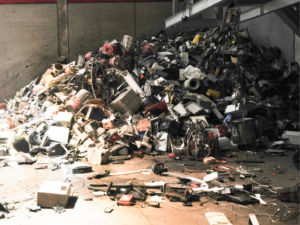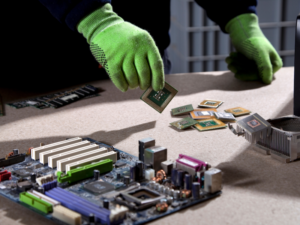We all use electronic devices every day. As anyone who’s ever owned any sort of electronic device knows, they aren’t meant to last forever. Some of us might use our devices as long as they continue to work, which might only be a few years, but many like to upgrade to new models frequently.
Regardless of why you buy new devices, we all need to upgrade eventually, which leaves us with many unwanted and unusable devices. Many don’t know what to do with these devices and think they can simply be thrown away, but getting rid of your old electronics is not that easy.
Due to electronics being discarded incorrectly, a huge amount of electronic waste pollutes landfills worldwide. According to the World Health Organization, of an estimated 53.6 million tonnes of e-waste produced globally in 2019, only 17.4% was formally collected and recycled. That means 44.3 million tonnes of potentially hazardous materials were left to harm the environment and people here.
It’s extremely important that everyone is educated on the dangers of e-waste and how they can prevent it. Learn more about why you should care about e-waste and how you can help save the planet.
E-Waste Produces Harmful Toxins
You use electronics all day, so surely they’re safe, right? As long as your devices are being maintained, they are safe for you to use and be exposed to. However, this isn’t the case for electronics that end up in landfills.
Soil and Water Pollution
When electronics are improperly disposed of (illegally dumped or taken to landfills), they can seep toxic materials. Some of the toxins found in e-waste include heavy metals like lead and mercury, which can leach into the soil. When this happens, the toxins can further spread, eventually contaminating crops and the livestock that feed on them. If we eat the crops or livestock, we may inadvertently consume these toxins. When toxins leak into the soil, they can also spread to bodies of water, making many communities’ water sources unsafe and harming ecosystems.
Air Pollution
In addition to toxins spreading through the soil, many landfills burn waste, which is extremely to the air quality. When electronics are burned, they release harmful toxins and greenhouse gas emissions into the air, exposing workers and nearby communities to them and harming their health. Not only are those close to the landfills affected, but once these toxins are in the air, they can travel far, putting many others at risk and harming the environment.
Throwing Out Electronics Wastes Materials
The effects that toxins from e-waste have can be devastating. While this is a huge issue and should be enough to make anyone concerned about the growing e-waste problem, it isn’t the only reason you should care. Even when your device is no longer usable, many of its elements and materials can still have another life.
Your everyday devices contain precious metals like gold, silver, and copper that can all be used to create new devices without the need to source new materials. These nonrenewable resources are finite, which means they will run out someday. Allowing old electronics to sit unused in landfills is, in simple terms, a huge waste.
Using the materials we already have access to and recycling unwanted electronics has many benefits. Since these materials are already sourced, creating new devices from recycled materials is much easier. By making an effort to recycle your old devices, you can help lower the demand for new materials to be sources for future products. You might even choose to find a project that can help you upcycle electronics yourself or find a local program that uses old electronics.
Economic Aspects of E-Waste
The economic implications of e-waste are as significant as their environmental impact. With millions of tonnes of electronic waste generated globally each year, there’s a hidden treasure trove of resources being squandered.
A Potential Goldmine
We already discussed how throwing out old electronics wastes materials, but we haven’t considered the cost and potential profit in recycling e-waste versus throwing it away. The truth is, your old electronic devices are more valuable than you might think. Containing precious metals like gold, silver, and copper, these discarded items hold immense economic value.
To put this into perspective, recycling just one million cell phones can recover approximately 35,000 pounds of copper, 772 pounds of silver, 75 pounds of gold, and 33 pounds of palladium. With the 53.6 million tonnes of e-waste generated in 2019, the lost opportunity is staggering. The estimated value of raw materials in this unrecycled e-waste is nearly $47 billion.
The Cost of Neglect
In addition to the potential cost positives of recycling negatives, it’s also important to look at the financial implications of not recycling e-waste. When these electronics are improperly disposed of, the financial loss extends beyond the value of recoverable materials.
The costs associated with environmental cleanup, health care for those affected by toxic waste exposure, and the loss of productivity due to illness represent substantial economic burdens. Moreover, relying on extracting new raw materials rather than recycling existing ones leads to increased mining costs and environmental degradation, further escalating the economic impact.
Closing the Loop: Find a Responsible Electronics Recycler
To ensure you’re doing your part in preventing toxic substances like e-waste from entering landfills, you need to work with an electronics recycling center that will responsibly handle all of your unwanted electronics.
At Newtech Recycling, we know how important the future of tech recycling is in protecting human health and our environment and are committed to providing businesses and organizations with a safe way to dispose of electronics. Together, we can do our part in reducing the amount of e-waste worldwide.
Contact Newtech Recycling today to see how we can help your business recycle your unwanted electronic devices.



